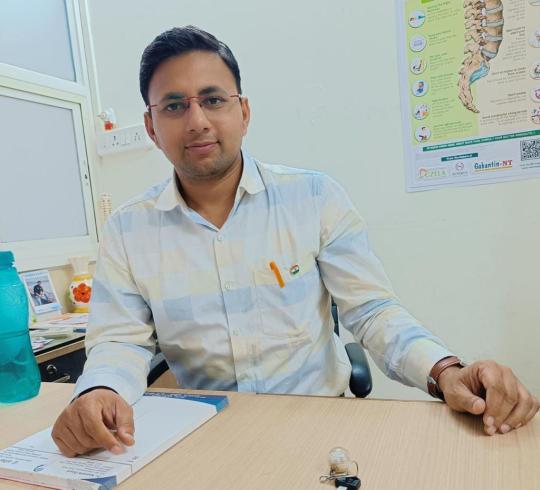#Neurointerventionalist in kota
Explore tagged Tumblr posts
Text
Different Types of Spine Surgery
Certainly! Spine surgery encompasses a variety of procedures aimed at treating different spinal conditions. Here are some common types of spine surgery:
Spinal Fusion:
Spinal fusion surgery involves joining (fusing) two or more vertebrae together using bone grafts or implants (such as metal rods and screws) Spine Surgeon in Kota. It's typically used to stabilize the spine and reduce pain in conditions like degenerative disc disease, spondylolisthesis, or spinal fractures.
Discectomy:
A discectomy is a surgical procedure to remove part or all of a damaged spinal disc that is causing nerve compression or pain. This is often performed to treat herniated discs that are pressing on spinal nerves.
Laminectomy:
A laminectomy involves removing part of the lamina (the bony arch of the vertebra) to relieve pressure on the spinal cord or nerves. It's commonly used to treat spinal stenosis, where the spinal canal narrows and puts pressure on the spinal cord or nerve roots.
Foraminotomy:
A foraminotomy is a procedure to enlarge the space where the nerve roots exit the spinal column (neural foramen). It's done to relieve pressure on compressed nerves due to conditions such as foraminal stenosis or herniated discs.
Vertebroplasty and Kyphoplasty:
These are minimally invasive procedures used to treat vertebral compression fractures, often caused by osteoporosis. Vertebroplasty involves injecting bone cement into the fractured vertebra to stabilize it, while kyphoplasty involves using a balloon to create space before injecting the cement.
Artificial Disc Replacement:
In this procedure, a damaged spinal disc is replaced with an artificial disc implant. It aims to maintain motion at the affected spinal segment while reducing pain and maintaining spinal alignment.
Spinal Cord Stimulator Implantation:
This involves implanting a device near the spinal cord that delivers electrical impulses to block pain signals before they reach the brain. It's used for managing chronic pain conditions like failed back surgery syndrome or complex regional pain syndrome.
Deformity Correction (Scoliosis Surgery):
Surgery may be recommended to correct spinal deformities such as scoliosis (abnormal curvature of the spine). Techniques vary but may involve spinal fusion with instrumentation to straighten and stabilize the spine.
These are just a few examples of the types of spine surgery available. The choice of procedure depends on the specific spinal condition, severity of symptoms, and individual patient factors. It's important for patients to discuss their options thoroughly with a spine specialist to determine the most appropriate treatment plan.

#Best Neurosurgeon in Kota#Brain Tumor Treatment in Kota#Spine Tumor Surgeon in Kota#Brain Hemorrhage Surgeon in Kota#Spine Surgeon in Kota#Neurointerventionalist in kota
0 notes
Text

Dr. Kanishk Goyal:
A Pioneer in Neurointerventional Medicine
In the dynamic landscape of medical professionals, there are individuals whose dedication and expertise shine brightly, making a significant impact on the field. Dr. Kanishk Goyal stands as a pioneering figure in the realm of neurointerventional medicine. With a profound commitment to patient care, innovation, and the advancement of medical science, Dr. Goyal has emerged as a leading neurointerventionalist, providing groundbreaking solutions to intricate neurological challenges.
Neurointerventional medicine lies at the intersection of neurology, radiology, and vascular surgery, requiring a deep understanding of the intricacies of the nervous system and its associated blood vessels. Dr. Kanishk Goyal's journey in this specialized field has been marked by an unwavering passion for pushing the boundaries of what is possible. His rigorous education, extensive training, and hands-on experience have equipped him with the knowledge and skillset to navigate the complexities of neurovascular conditions.
As a renowned neurointerventionalist, Dr. Goyal has earned recognition not only for his technical prowess but also for his empathetic approach to patient care. He understands that behind each medical case is a person, and every diagnosis carries a unique story. This compassionate outlook, coupled with his exceptional clinical acumen, has made Dr. Goyal a sought-after expert in addressing conditions like cerebral aneurysms, stroke, and arteriovenous malformations.
Dr. Goyal's contributions extend beyond his work with patients. He is actively engaged in research, collaborating with multidisciplinary teams to explore innovative techniques and technologies that could revolutionize the field of neurointerventional medicine. His commitment to advancing medical knowledge is evident through his publications, lectures, and participation in medical conferences, where he shares insights and experiences with colleagues worldwide.
In a rapidly evolving field like neurointerventional medicine, staying ahead requires not only expertise but adaptability. Dr. Kanishk Goyal exemplifies this trait, continuously learning about cutting-edge treatments and refining his techniques to provide the best possible outcomes for his patients. His holistic approach to patient care, combined with his dedication to education and research, paints a picture of a visionary medical professional who is shaping the future of neurointerventional medicine.
#Best Neurosurgeon in Kota#Brain Tumor Treatment in Kota#Spine Tumor Surgeon in Kota#Slip Disc Treatment in Kota#Brain Hemorrhage Surgeon in Kota#Best Slip Disc Surgeon in Kota#Neurointerventionalist in kota
1 note
·
View note